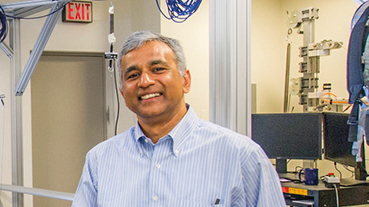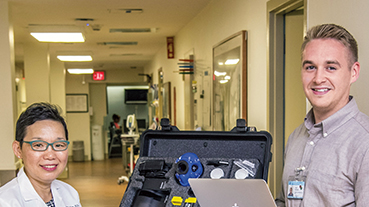Helen Hayes Hospital: Providing a New Dimension to Rehabilitation Training

Dr. Christopher J. Visco
As part of their comprehensive training, residents in the Physical Medicine and Rehabilitation Residency Program at NewYork-Presbyterian benefit from a diverse and broad curriculum with exposure to clinical experiences in highly regarded institutions. “In order to train the next generation of physiatrists to be outstanding, we need to challenge them,” says Christopher J. Visco, MD, Ursula Corning Associate Professor and Vice Chair of Education in the Department of Rehabilitation and Regenerative Medicine at NewYork-Presbyterian. “And what better challenge is there than to care for patients who need rehabilitation the most — the kinds of patients cared for at Helen Hayes Hospital. These are patients with some of the most debilitating conditions, including those with spinal cord and brain injuries. Helen Hayes Hospital provides that advanced, specialized care, drawing patients from all over the country.”
Dr. Visco, who is also the Residency Program Director, cites Helen Hayes Hospital’s well-earned reputation for excellence in rehabilitation medicine. “The Hospital has exceptional educators who are leaders in the field. During their residency rotations at Helen Hayes, our junior and senior trainees are exposed to inpatient care, work with advanced adaptive technology solutions, and participate in high-level planning and fabrication of prosthetics and orthotics.”
Located in Haverstraw, New York, some 40 miles north of Manhattan on a 100-acre campus, Helen Hayes Hospital is renowned for its application of the most sophisticated technology and innovative research-based rehabilitation techniques to patient care. The 155-bed, New York State-operated hospital provides therapeutic care on an inpatient and outpatient basis for individuals of all ages with a wide array of disabilities and conditions, including spinal cord injury, stroke, traumatic brain injury, cardiac and pulmonary disorders, amputations, joint replacements, cerebral palsy, and neurological disorders.
The Hospital’s programs include its nationally recognized Center for Rehabilitation Technology, which provides advanced adaptive technology solutions. Aquatic therapies and a Smart Apartment — a working replica of a home outfitted with adaptive technology solutions for daily living — are also among the many approaches employed to maximize recovery and help patients gain independence.
Rehabilitation Training in Complex Cases
The strength of the Spinal Cord Injury Rehabilitation Program at Helen Hayes Hospital is its capacity to address all of the complex effects of spinal cord injury, including paraplegia and quadriplegia, respiratory disorders, bowel and bladder dysfunction, wound care and spasticity, as well as emotional and psychological issues related to adjustment to a new way of life. Patients with spinal cord injury are admitted directly to a specially designed and equipped unit with round-the-clock monitoring and the capability to care for patients with feeding tubes and ventilators.
Dr. Visco believes the experience of working with patients facing life-altering injuries and diseases that challenge the human resilience and spirit is particularly educational for the residents. “At Helen Hayes, our residents experience training that can change their understanding of recovery,” says Dr. Visco. “They work with patients wrestling in many ways with some of the most challenging medical circumstances.”

Dr. Victoria Lent
(Photo: George Mattei)
Victoria Lent, MD, Director of Spinal Cord Rehabilitation Services at Helen Hayes Hospital, and Maria A. Boiano, DO, oversee the PGY2 residents, whose seven-week rotation focuses on patients with spinal cord, traumatic brain, and multi-trauma injuries, as well as amputation, burns, and cardiopulmonary issues. “These residents are very new to rehabilitation,” says Dr. Lent. “Training for the PGY2 residents at Helen Hayes Hospital is much less about service and documentation requirements and much more experiential. We want them to spend time getting to know the patients and their stories, interacting with them and observing them as they go through their therapies, and gaining an understanding of what the rehabilitation process is like for them.”
On the inpatient unit, Dr. Lent notes that residents benefit from understanding the medical issues that patients with spinal cord injuries or an amputation face. “The residents learn about the medical issues to consider acutely and down the line, and also appreciate the roles of the various team members that comprise the patient’s rehabilitation process.”

Dr. Maria A. Boiano
(Photo: George Mattei)
Training also emphasizes multiple modalities in pain management. “We consult with the anesthesia group, as well as the neurologists, for some of the most complex patients,” Dr. Boiano says. “Pain and spasticity management is a team effort. On the inpatient side we work with our psychiatry and psychology colleagues who offer non-pharmacological methods for managing pain. I can offer osteopathic techniques and acupuncture. Physical and occupational therapy, heat and ice, and electrical stimulation all play a role in managing pain. Our residents receive a complete picture of care in this area.”
“In addition, the residents come with us to the clinic so they can see the continuity of care in the whole spectrum of rehabilitation from acute to more chronic issues,” says Dr. Lent. The outpatient clinic experience includes participation in special programs such as the Adaptive Driving Program for hemiplegic patients, which occurs in a simulated setting and with an adapted van with hand controls.
“The technology component of training at Helen Hayes is remarkable,” notes Dr. Visco. “Voice-activated systems and motion and touch sensors available through the Hospital’s Center for Rehabilitation Technology support those activities that are so important for daily life.”
Dr. Lent is also pursuing research on exoskeletons. “Though exoskeletons have been around for some time, we’re doing research in order to find out the value beyond gait training that might come from using some of these devices,” she says. “There are bowel and bladder control effects, spasticity and pain reduction, and these benefits are not clearly understood.” Dr. Lent believes this type of research is another vital component of the training residents receive at Helen Hayes Hospital.
“Many of our patients have had life-changing events, but the acute care facilities they have come from do not necessarily prepare them to transition to their next phase of life,” says Dr. Boiano. “I love that the residents can see that we do our best as a team to educate and transition our patients for what comes next in their lives. They don’t simply witness this; they participate in the process.”

Dr. Neal Rakesh
(Photo: George Mattei)
Neal Rakesh, MD, PGY2, has had an interest in applying technology to patient care since his undergraduate years at the University of Michigan, where he studied biomedical engineering. “I was particularly interested in the brain/computer interface at the time, which essentially can create a physical manifestation of something neurologic,” says Dr. Rakesh.
His interest in technology continued into medical school where he gravitated toward a field that involved technological advances. “Rehabilitation medicine is advancing more quickly in technology than other specialties,” says Dr. Rakesh. When considering residency programs, Dr. Rakesh was drawn to the work of Joel Stein, MD, Physiatrist-in-Chief at NewYork-Presbyterian.
“Dr. Stein had the vision of implementing technology as a means to gauge someone’s recovery or to enhance someone’s overall functioning,” says Dr. Rakesh. “That excited me as well, resulting in my foray into the rehabilitation world.”
For Dr. Rakesh, the residency rotation at Helen Hayes Hospital affords him the opportunity to further explore his passion for technology with real-life applications to help patients with injuries to the spinal cord. “I’m fascinated by the spinal cord as it relates to being able to control the function of limbs and internal organs and regulation of temperature and blood pressure,” he says. “The more you understand about the spinal cord, the better you are able to treat your patients.”
The more seasoned PGY4 residents work under the supervision of Glenn M. Seliger, MD, Director of Traumatic Brain Injury Rehabilitation Services at Helen Hayes Hospital. This rotation includes medical management of inpatient comorbidities, such as hypertension, diabetes, coronary artery disease, and COPD.
“When the residents come back from their rotations at Helen Hayes Hospital, they perform at a higher level in the subspecialty domains of spinal cord injury and brain injury,” Dr. Visco says. “We’re very pleased with our association and the extraordinary training our residents undergo with the team at Helen Hayes.”
Related Publications

The Potential of Robotics: Making Strides in Spinal Cord Injury





